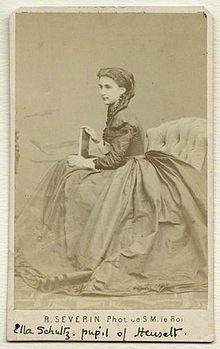This is an old revision of this page, as edited by Smerus (talk | contribs) at 22:11, 22 January 2016. The present address (URL) is a permanent link to this revision, which may differ significantly from the current revision.
Revision as of 22:11, 22 January 2016 by Smerus (talk | contribs)(diff) ← Previous revision | Latest revision (diff) | Newer revision → (diff)

Ella Georgiyevna Adayevskaya (Template:Lang-ru; 22 February 1846 [O.S. 10 February] – 26 July 1926) was a Russian composer, pianist, and ethnomusicologist.
Adayevskaya wrote vocal music (including choral works), chamber music, and two operas. She also edited a collection of Italian songs and published writings on folk music and the music of ancient Greece.
Life
Born in St. Petersburg on 22 February 1846 as Elizaveta/Elisabeth von Schultz, Adayevskaya began learning the piano in childhood. amongst her teachers were Adolf von Henselt, Anton Rubinstein and Alexander Dreyschock. She studied composition with Alexander Famintsyn and Nikolai Zaremba. Adayevskaya was a pseudonym derived from the notes A, D, and A, played by the kettledrum in Mikhail Glinka's opera Ruslan and Ludmila.
Her earliest works include choruses written for the Russian Imperial Chapel Choir. In the 1870s she wrote two operas. The first, titled Neprigozhaya (The Ugly Girl) (in the composer's German manuscript Salomonida, die Tochter des Bojaren, Salomonida, The Boyar's Daughter), was a one-act piece written in 1873. The more ambitious Zarya (Dawn, German title Die Morgenröte der Freiheit (The Dawn of Freedom) ) followed in 1877; this four-act work was dedicated by the composer to Tsar Alexander II, but was rejected by the censor. Later, she embarked on several solo concert tours of Europe and settled in Venice in 1882. In 1881, she composed her Greek Sonata for clarinet and piano, which used quarter tones. In Italy she collected national songs, among others songs of the people of the Raetia region in quintuple metre.
In 1911 she moved to Neuwied where was associated with the circle of the poet Carmen Sylva and published many articles on folk music.
Adayevksaya died in Bonn in 1926. She was buried in the Alter Friedhof, Bonn.
Works
Operas
- Neprigozhaya (The Ugly Girl), 1873
- Zarya (Dawn), 1877
Vocal music
- Yolka (The Fir Tree), cantata, c. 1870; also
- other choral works, songs
Chamber music
- Greek Sonata for clarinet and piano, 1881
- piano pieces
Notes
References
- Brown, Malcolm Hamrick (n.d.). "Adayevskaya , Ella Georgiyevna." in Oxford Music Online, accessed 22 January 2016. (subscription required)
- Eaglefield-Hull, A. (1924). A Dictionary of Modern Music and Musicians London: Dent.
- Hüsken, Renate (2005). Ella Adaïewsky (1846-1926): Pianistin – Komponistin – Musikwissenschaftlerin. Cologne: Dohr. ISBN 3-936655-18-9.
External links
- Biographer Renate Hüsken's website on Adaïewsky (in German)
- Free scores by Ella Adayevskaya at the International Music Score Library Project (IMSLP)